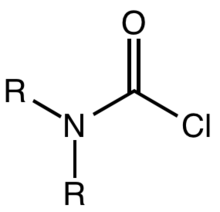Carbamic acid
| |||
| Names | |||
|---|---|---|---|
| IUPAC name
Carbamic acid | |||
| Other names
Aminomethanoic Acid | |||
| Identifiers | |||
3D model (JSmol) |
|||
| ChEBI | |||
| ChEMBL | |||
| ChemSpider | |||
| DrugBank | |||
| KEGG | |||
| MeSH | Carbamic+acid | ||
PubChem CID |
|||
| |||
| |||
| Properties | |||
| CH3NO2 | |||
| Molar mass | 61.04 g·mol−1 | ||
| Related compounds | |||
Related compounds |
Formamide Dithiocarbamate Carbonic acid Urea Ethyl carbamate | ||
Except where otherwise noted, data are given for materials in their standard state (at 25 °C [77 °F], 100 kPa). | |||
| Infobox references | |||
Carbamic acid is the compound with the formula H2NCOOH. The attachment of the acid group to a nitrogen or amine (instead of carbon) distinguishes it from carboxylic acid and an amide. Many derivatives and analogues of carbamic acid are known. They are generally unstable, reverting to the parent amine and carbon dioxide.[1] The deprotonated anion (or conjugate base) of this functional group is a carbamate. Carbamic acid is a planar molecule.[2]
Occurrence
Carbamic acid is an intermediate in the production of urea, which involves the reaction of carbon dioxide and ammonia.[3]
- CO2 + NH3 → H2NCOOH
- H2NCOOH + NH3 → CO(NH2)2 + H2O
Carbamoyltransferases are transferase enzymes classified under EC number 2.1.3.
Derivatives of carbamic acid
 carbamic acid group
carbamic acid group carbamate group
carbamate group carbamoyl (Cbm) group
carbamoyl (Cbm) group carbamoyl chloride group
carbamoyl chloride group
Carbamic acids are intermediates in the decomposition of carbamate protecting groups; the hydrolysis of an ester bond produces carbamic acid the evolution of carbon dioxide drives the deprotection reaction forward, yielding the unprotected amine.
Carbamates usually refer to esters of carbamic acid. Methyl carbamate is the simplest ester of carbamic acid. Unlike carbamic acids, the esters are stable. They are prepared by reaction of carbamoyl chlorides with alcohols, the addition of alcohols to isocyanates, and the reaction of carbonate esters with ammonia.[4]
Some esters have use as muscle relaxants which bind to the barbiturate site of the GABAA receptor,[5] while others are used as insecticides, for example aldicarb.[6]
See also
References
- ↑ Lemke, Thomas L. (2003). Review of Organic Functional Groups: Introduction to Medicinal Organic Chemistry. Philadelphia, PA: Lippincott, Williams & Wilkins. p. 63. ISBN 978-0-7817-4381-5.
- ↑ Khanna, R. K.; Moore, M. H. (1999). "Carbamic acid: Molecular structure and IR spectra". Spectrochimica Acta Part A: Molecular and Biomolecular Spectroscopy. 55 (5): 961–7. Bibcode:1999AcSpA..55..961K. doi:10.1016/S1386-1425(98)00228-5. PMID 10347902.
- ↑ Meessen, J. H.; Petersen, H., "Urea", Ullmann's Encyclopedia of Industrial Chemistry, Weinheim: Wiley-VCH, doi:10.1002/14356007.a27_333
- ↑ Jäger, Peter; Rentzea, Costin N.; Kieczka, Heinz (2000). "Carbamates and Carbamoyl Chlorides". Ullmann's Encyclopedia of Industrial Chemistry. doi:10.1002/14356007.a05_051. ISBN 3527306730.
- ↑ Block, John H.; Beale, John M., eds. (2004). "Central Nervous System Depressant". Wilson and Gisvold's Textbook of Organic Medicinal and Pharmaceutical Chemistry. Philadelphia, PA: Lippincott, Williams & Wilkins. p. 495. ISBN 978-0-7817-3481-3.
- ↑ Risher, John F.; Mink, Franklin L.; Stara, Jerry F. (1987). "The Toxicologic Effects of the Carbamate Insecticide Aldicarb in Mammals: A Review". Environmental Health Perspectives. 72: 267–281. doi:10.2307/3430304. JSTOR 3430304. PMC 1474664. PMID 3304999.

